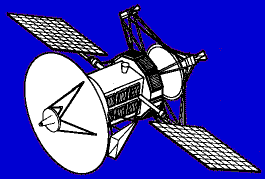Geological Society of America - Newsroom - Heavy Metal Frost? A New Look at a Venusian Mystery
Elise Harrington; Allan Treiman (LPI) Radar-‐bright Highlands on Venus: Confirmation of a Ferroelectric Substance 2014_August_Treiman.pdf
 |
| Magellan Spacecraft |
The idea that the Venusian highlands are covered in a ‘metallic frost’ dates back to 1995, when Dr Raymond Arvidson of the Washington University’s McDonnell Center for the Space Sciences and his colleagues were analyzing the rich archives of data taken from Magellan mission in the 1990's. Magellan’s primary objective was to map the surface of Venus using a technique known as synthetic aperture radar (SAR). SAR images taken of mountainous regions in the planet’s highlands revealed a mysterious brightening effect. Scientists surmised that this effect was due to a metal-containing ‘frost’ only a few millimeters in thickness frosting the mountains’ rugged surfaces.
Ms Harrington and her colleague, Dr Allan Trieman of Lunar and Planetary Institute, re-purposed the old Magellan data.
- use of stereo radar elevation data rather than the lower resolution radar altimetry. increased their altimetry resolution from seeing patches 8 by 12 km to just 0.6 x 0.6 km.
- Magellan’s SAR, with its 75×75-m footprint, to look at radio reflectance, rather than the data on radio emissions from the surface, which had a coarser 15 by 23 km resolution.
“Our data supports the interpretation that the radar properties of Ovda could be explained by the presence of ferroelectric substance at its surface,” the scientists said.
ASP: The Magellan Spacecraft at Venus
The Surface Features of Venus
 Our knowledge concerning the surface of Venus comes from a limited amount of
information obtained by the series of Russian Venera landers, and primarily
from extensive radar imaging of the planet. The radar imaging of the planet
has been performed both from Earth-based facilities and from space probes.
The most extensive radar imaging was obtained from the Magellan orbiter in a
4-year period in the
early 1990s. As a consequence, we now have a detailed radar picture of
the surface of Venus. The adjacent animation shows the topography of the
surface as determined using the Magellan synthetic aperture radar (black areas
are regions not examined by Magellan). An
MPEG movie (303 kB) of this animation is also
available.
Our knowledge concerning the surface of Venus comes from a limited amount of
information obtained by the series of Russian Venera landers, and primarily
from extensive radar imaging of the planet. The radar imaging of the planet
has been performed both from Earth-based facilities and from space probes.
The most extensive radar imaging was obtained from the Magellan orbiter in a
4-year period in the
early 1990s. As a consequence, we now have a detailed radar picture of
the surface of Venus. The adjacent animation shows the topography of the
surface as determined using the Magellan synthetic aperture radar (black areas
are regions not examined by Magellan). An
MPEG movie (303 kB) of this animation is also
available.
Overview of Surface
The surface of Venus is rather smooth in many places, though not nearly as smooth as originally expected . However, we find evidence for many of the same geological features found on Earth: canyons, volcanoes, lava flows, rift valleys, mountains, craters, and plains. There is substantial evidence for local tectonic activity but the surface appears to be a single crustal plate, with little evidence for large-scale horizontal motion of crustal plates as found on the Earth. Why the two planets differ in this aspect of their geology even though we believe them to have similar interiors is not well understood. The usual explanation is that Venus is a little behind the Earth in geological timescale, and its tectonic activity is just getting started. Much of the surface of Venus appears to be rather young. The global data set from radar imaging reveals a number of craters consistent with an average Venus surface age of 300 million to 500 million years.There are two "continents", which are large regions several kilometers above the average elevation. These are called Istar Terra and Aphrodite Terra. They can be seen in the preceding animation as the large green, yellow, and red regions indicating higher elevation near the equator (Aphrodite Terra) and near the top (Ishtar Terra).


No comments:
Post a Comment